
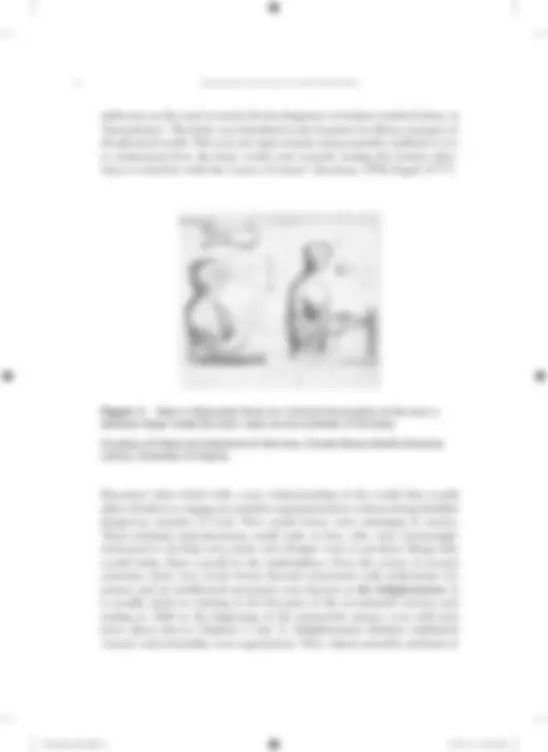
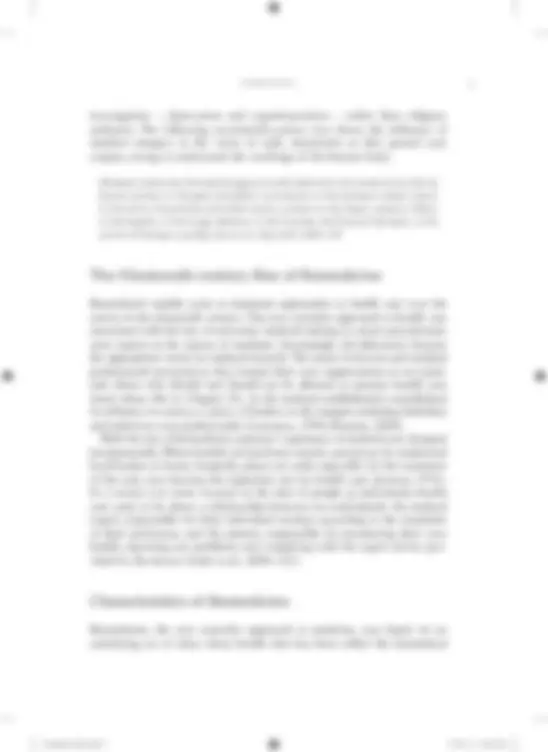
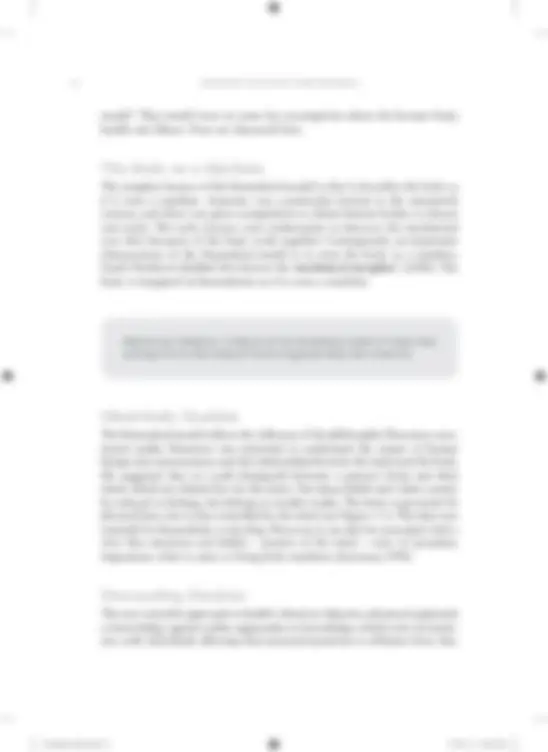
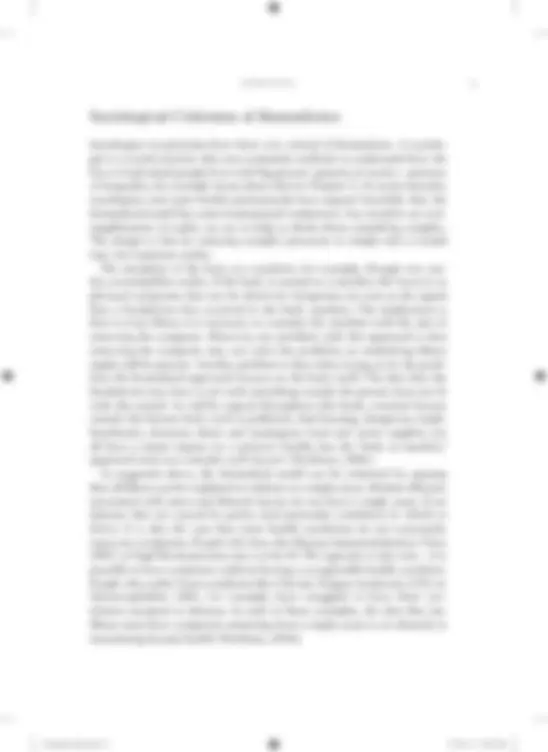


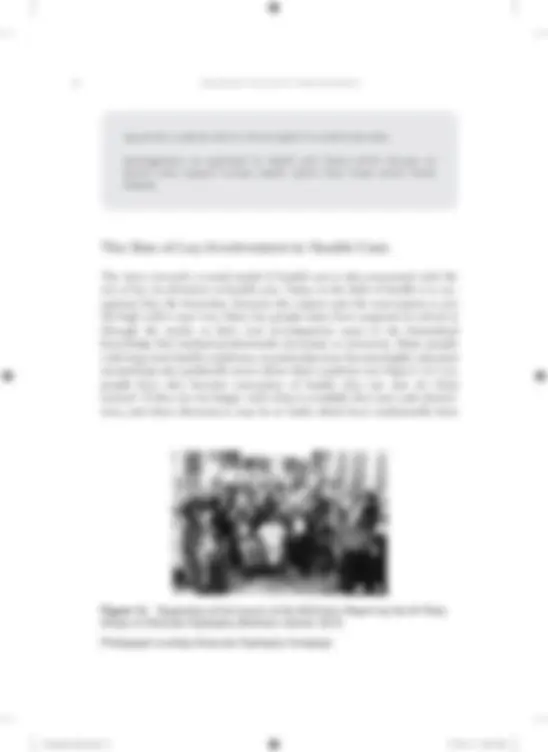
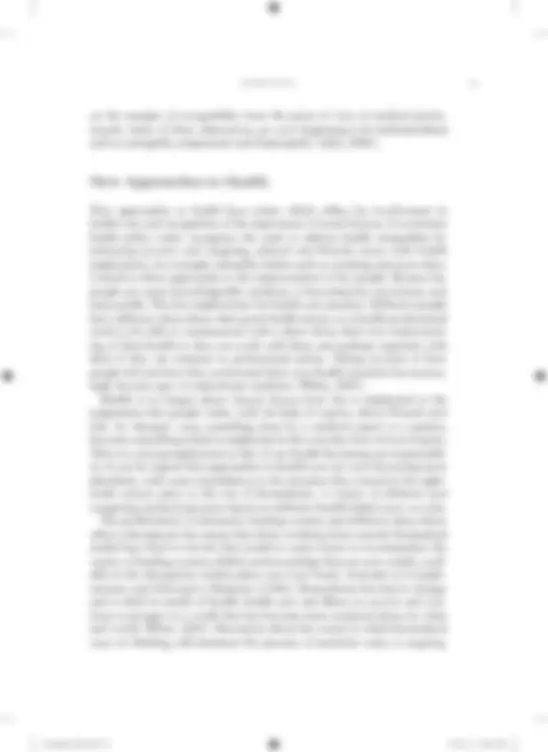
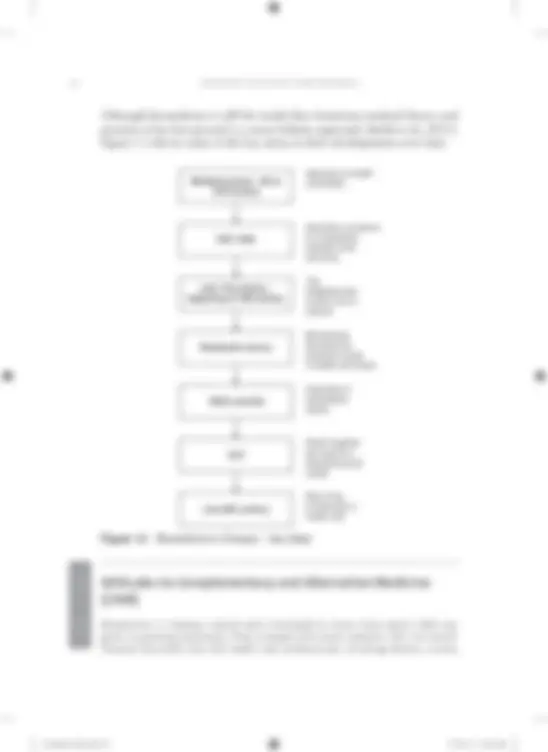


Study with the several resources on Docsity

Earn points by helping other students or get them with a premium plan


Prepare for your exams
Study with the several resources on Docsity

Earn points to download
Earn points by helping other students or get them with a premium plan
Community
Ask the community for help and clear up your study doubts
Discover the best universities in your country according to Docsity users
Free resources
Download our free guides on studying techniques, anxiety management strategies, and thesis advice from Docsity tutors
Biomedicine, biomedical model: an approach to health and illness which defines illness as the absence of disease, portraying the human organ ...
Typology: Study notes
1 / 17

This page cannot be seen from the preview
Don't miss anything!










When you think about health care, what images come to mind? You may picture uniforms and sterile floors, white coats, plastic gloves and patients lined up in bed. It seems like ‘common sense’ to think about health in this way. However, this way of thinking about health is fairly recent. Our twenty-first century ideas about health can be traced back to the nineteenth century and the rise of an approach to human health that we now call ‘ bio- medicine ’. Looking at the early history of biomedicine can help us to stand
Biomedicine 7 back from our own experience of health and health care and think about what health means from a wider perspective. Biomedicine, biomedical model: an approach to health and illness which defines illness as the absence of disease, portraying the human organ- ism as either functioning ‘normally’ or else dysfunctional and therefore diseased.
Our society still places great value on science and a scientific approach to problems, seen as rational, objective and unbiased. But for most of human history people did not aspire to being ‘scientific’. In medieval Europe, life revolved around the church, and society was dominated by religious ideas. People believed that the source of knowledge was God. Knowledge should only be acquired through God’s agents on earth, priests, who were morally equipped to interpret the word of God as expressed in the Bible. To tamper with nature was seen as immoral, because nature existed as it did because it was ‘God’s will’. Ideas about human health were situated within this framework. For example, people who had visual and auditory hallucina- tions and would today be diagnosed as suffering from schizophrenia were considered to be possessed by demons. Health care, for those who could afford it, was carried out by a variety of healers who might have quite dif- ferent ideas about how to effect a cure (Elmer, 2004). By the sixteenth and seventeenth centuries, European society was chang- ing in a way that would affect the rest of the world. One person who was important in the development of new ideas was René Descartes (1596–1650), often referred to as the founder of modern philosophy. Descartes is signifi- cant in relation to health because he was the most important thinker to articulate clearly a view which suggested that the mind and the body are two separate spheres. He argued that the body could be seen as part of the phys- ical world and the mind as part of the spiritual world (see Figure 1.1). The mind and body are connected, but separate. This idea was an important
Biomedicine 9 investigation – observation and experimentation – rather than religious authority. The following seventeenth-century text shows the influence of machine imagery in the views of early anatomists as they peered over corpses, trying to understand the workings of the human body: Whoever examines the bodily organism with attention will certainly not fail to discern pincers in the jaws and teeth: a container in the stomach: water-mains in the veins, the arteries and other ducts; a piston in the heart; sieves or filters in the bowels; in the lungs, bellows; in the muscles, the force of the lever; in the corner of the eye, a pulley, and so on. (Synnott, 1993: 23)
Biomedicine rapidly came to dominate approaches to health care over the course of the nineteenth century. This new scientific approach to health was associated with the rise of university medical training to ensure practitioners were experts in the science of medicine. Increasingly, the laboratory became the appropriate venue for medical research. The status of doctors and medical professionals increased as they formed their own organizations to set stand- ards about who should and should not be allowed to practice health care (more about this in Chapter 10). As the medical establishment consolidated its influence in society, a variety of healers on the margins including herbalists and midwives were pushed aside (Lawrence, 1994; Brunton, 2004). With the rise of biomedicine, patients’ experience of medical care changed fundamentally. Where health care had been mainly carried out by traditional local healers at home, hospitals, places set aside especially for the treatment of the sick, now became the important site for health care (Jewson, 1976). In a society ever more focused on the idea of people as individuals, health care came to be about a relationship between two individuals: the medical expert, responsible for their individual conduct according to the standards of their profession, and the patient, responsible for monitoring their own health, reporting any problems and complying with the expert advice pro- vided by the doctor (Gabe et al., 2004: 125).
Biomedicine, the new scientific approach to medicine, was based on an underlying set of ideas about health that has been called ‘the biomedical
10 SOCIOLOGY FOR HEALTH PROFESSIONALS model’. That model rests on some key assumptions about the human body, health and illness. Four are discussed here.
The simplest feature of the biomedical model is that it describes the body as if it were a machine. Anatomy was a particular interest in the nineteenth century, and there was great competition to obtain human bodies to dissect and study. The early doctors were enthusiastic to discover the mechanical way that the parts of the body work together. Consequently, an important characteristic of the biomedical model is to treat the body as a machine. Sarah Nettleton labelled this feature the ‘ mechanical metaphor ’ (2006). The body is imagined in biomedicine as if it were a machine. Mechanical metaphor: a feature of the biomedical model of illness that portrays the human body as functioning essentially like a machine.
The biomedical model reflects the influence of the philosopher Descartes, men- tioned earlier. Descartes was interested to understand the nature of human beings and consciousness and the relationship between the mind and the body. He suggested that we could distinguish between a person’s brain and their mind, which are related, but not the same. Our ideas, beliefs and values cannot be reduced to biology, but belong to another realm. The body is governed by physical laws, but is also controlled by the mind (see Figure 1.1). This idea was essential for biomedicine to develop. However, it can also be associated with a view that emotions and beliefs – matters of the mind – were of secondary importance when it came to fixing body-machines (Seymour, 1998).
The new scientific approach to health valued an objective, distanced approach to knowledge, against earlier approaches to knowledge, which were inconsist- ent, with individuals allowing their personal positions to influence how they
12 SOCIOLOGY FOR HEALTH PROFESSIONALS science in general. New inventions and discoveries seemed to promise that science could solve many of humanity’s problems. The Second World War, however, marked a point at which faith in science faltered. In particular, the 1945 bombing of Hiroshima, an act made possible by recent scientific advance, demonstrated that scientific progress could result in catastrophic destruction and loss of life. Medical science also, despite its many achievements, began to deliver dis- appointments in the post-war years. Perhaps symbolic of this were the 12,000 babies born in the 1960s with shorter or missing limbs before the withdrawal of the morning sickness drug Thalidomide (Sargent, 2005: 240). The question of whether there would be a price to be paid for every cure found began to be asked. The 1960s also marked a time where people in countries across the world mobilized in a variety of social movements to confront governments whose authority had been called into question. One outcome of those movements was a cultural shift which saw populations become more politically aware and unwilling to accept the claims of elites claiming to act in their best interests. In addition, the nature of illness changed. In the nineteenth century, germs were a major factor in morbidity and mortality. In that context a focus on finding the ‘single cause’ behind every illness made sense. How- ever, from the mid-twentieth century, infectious disease became less impor- tant and the major causes of death were cancer and cardiovascular disease. Lifestyle and stress are now the most important threats to good health. Though childhood and infectious diseases remain major killers in the majority world , in the wealthiest countries today the major medical problems are chronic illnesses, conditions which have multiple causes (McKeown, 1979). As a consequence of all these social changes, after peaking in the 1950s the biomedical model began to be the target of increasing criticism. In recent decades biomedicine has been challenged from many quarters, including by a variety of health care professionals. As a result, conceptions of health and illness and health care practice have had to change (Wade and Halligan, 2004). Majority world: a term used in preference to ‘developing’ or ‘third world’ countries, which attempts to avoid describing those countries in terms of how they appear from the viewpoint of those in the wealthiest countries.
Biomedicine 13
Sociologists in particular have been very critical of biomedicine. A sociolo- gist is a social scientist who uses systematic methods to understand how the lives of individual people fit in with ‘big picture’ patterns in society – patterns of inequality, for example (more about that in Chapter 3). In recent decades, sociologists and some health professionals have argued forcefully that the biomedical model has some fundamental weaknesses. Any model is an over- simplification of reality we use to help us think about something complex. The danger is that by reducing complex processes to simple ones a model may mis- represent reality. The metaphor of the body as a machine, for example, though very use- ful, oversimplifies reality. If the body is treated as a machine the focus is on physical symptoms that can be observed. Symptoms are seen as the signal that a breakdown has occurred in the body machine. The implication is that to treat illness it is necessary to examine the machine with the aim of removing the symptom. However, one problem with this approach is that removing the symptom may not solve the problem; an underlying illness might still be present. Another problem is that when trying to fix the prob- lem, the biomedical approach focuses on the body itself. The idea that the breakdown may have to do with something outside the person does not fit with this model. As will be argued throughout this book, external factors outside the human body such as pollution, bad housing, dangerous neigh- bourhoods, domestic abuse and inadequate food and water supplies can all have a major impact on a person’s health, but the ‘body as machine’ approach does not consider such factors (Nettleton, 2006). As suggested above, the biomedical model can be criticized for arguing that all illness can be explained in relation to a single cause. Modern illnesses associated with stress and lifestyle factors do not have a single cause. Even diseases that are caused by germs need particular conditions in which to thrive. It is also the case that some health conditions do not necessarily cause any symptoms. People who have the Human Immunodeficiency Virus (HIV) or high blood pressure may not be ill. The opposite is also true – it is possible to have symptoms without having a recognizable health condition. People who suffer from conditions like Chronic Fatigue Syndrome (CFS) or Myoencephalitis (ME), for example, have struggled to have these syn- dromes accepted as diseases. In each of these examples, the idea that any illness must have symptoms stemming from a single cause is an obstacle to maximizing human health (Nettleton, 2006).
Biomedicine 15
In response to the various limitations of biomedicine already discussed, attempts have been made to devise a new model for health and illness, one that retains what is most useful in biomedicine but addresses some of its weaknesses. Today we can talk about the social model (Morgan et al., 1985), or the biopsychosocial model, a model conceptualized by the psy- chiatrist George Engel. Working every day with people struggling with psychiatric problems, the psychiatrist George Engel was particularly aware that there was a problem with the idea that the mind and the body should be considered separately. Engel argued that the boundaries between health and illness are not clear because both ideas are influenced by cultural, social and psychological considerations. The job of the psychiatrist, Engel argued, should be to weigh up what balance of social, psychological and biological factors have led to the person feeling unwell or having a problem function- ing as they think they should. A biopsychosocial model, he argued, would recognize that it is the physician’s role to accept responsibility to evaluate whatever problem the patient presents and recommend a course of action. The focus of this biopsychosocial practice would be not just a body in need of repair but a thinking, feeling, social being, that is, a being with a bio- logical, a psychological and a social self (Engel, 1977). Biopsychosocial model: an approach to health and illness which sees ill- ness as reflecting psychological and social as well as biological factors. In what ways is the self social? The social model of health emphasizes in particular the role of wider society in how we experience and understand health issues. The social model of health emphasizes the multiple roots of health issues and the diverse possibilities for achieving health out- comes. For example, we think about the impact on a person’s health of their class, their gender, their age, ethnicity, any disabilities they have and their sexuality. Social factors include issues such as poverty and housing which form an essential part of the wider context in which bio- logical processes take place. In addition, social factors refer not only to our interactions with people close to us (our ‘social life’, as it is infor- mally known) but to our indirect engagement with norms and values
16 SOCIOLOGY FOR HEALTH PROFESSIONALS shared by people we have not met and groups which we may only vaguely be aware of being part of. These norms and values make up the culture of our society. Our ideas about what is and what isn’t a medical problem are ideas we learn in the context of our society and those ideas have implications for health care. Social factors: factors which affect an individual and involve other peo- ple, including the many people to whose lives we are indirectly connected even though we may never have met them (for example, wider social groups to which we are connected such as our class, gender, ethnic group, sexuality and nation). Norms: informal understandings amongst groups of people about the right way to behave. It is also useful to think of some health issues as psychosocial. There are particular events and experiences in our society which put stress on human beings and our ability to cope. Sociological studies have explored, for exam- ple, adverse affects on health produced by socio-cultural instability, rapid social change, being isolated or struggling to make ends meet (Marmot and Wilkinson, 2009). This concept will be explored again in Chapter 3 and in other chapters of this book. It is easy to see what can happen if medical experts do not have an awareness of these kinds of factors. Imagine, for example, a person who has unexplained physical symptoms which are asso- ciated with ongoing abuse or alcoholism. If these factors are not recognized, a traditional biomedical response might be to prescribe the patient pain killers or some other kind of medication, a strategy which may only lead to new problems and does not go to the main cause of the problem anyway (see Case Study: Women’s Chronic Pelvic Pain). Psychosocial factors: social experiences and environments which cause stress for individuals, making them more vulnerable to illness.
18 SOCIOLOGY FOR HEALTH PROFESSIONALS Lay person: a person who is not an expert in a particular area. Salutogenesis: an approach to health and illness which focuses on factors that support human health rather than those which foster disease.
The move towards a social model of health care is also associated with the rise of lay involvement in health care. Today in the field of health it is rec- ognized that the boundary between the experts and the non-experts is not the high wall it once was. Many lay people today have acquired at school or through the media or their own investigations some of the biomedical knowledge that medical professionals encounter at university. Many people with long-term health conditions, in particular, have become highly educated and perhaps also politically active about their condition (see Figure 1.2). Lay people have also become consumers of health who can and do ‘shop around’. If they are not happy with what is available they may seek alterna- tives, and these alternatives may be in fields which have traditionally been Figure 1.2 Supporters at the launch of the McCollum Report by the All Party Group on Muscular Dystrophy (Northern Ireland, 2012) Photograph courtesy Muscular Dystrophy Campaign
Biomedicine 19 on the margins of acceptability from the point of view of medical profes- sionals. Some of these alternatives are even beginning to be institutionalized such as osteopathy, acupuncture and homeopathy (Saks, 2006).
New approaches to health have arisen which reflect lay involvement in health care and recognition of the importance of social factors. Government health policy today recognizes the need to address health inequalities by redressing poverty and targeting cultural and lifestyle issues with health implications, for example unhealthy habits such as smoking and poor diets. Central to these approaches is the empowerment of lay people. Because lay people are more knowledgeable, medicine is becoming less mysterious and inaccessible. This has implications for health care practice. Different people have different ideas about what good health means, so a health professional needs to be able to communicate with a client about their own understand- ing of their health so they can work with them and perhaps negotiate with them if they are resistant to professional advice. Taking account of how people feel and how they understand their own health situation has increas- ingly become part of mainstream medicine (White, 2005). Health is no longer about ‘doctor knows best’ but is implicated in the judgements that people make, with the help of experts, about lifestyle and risk. So ‘therapy’, once something done by a medical expert to a patient, becomes something which is implicated in the everyday lives of non-experts. There is a strong implication in this of our health becoming our responsibil- ity. It can be argued that approaches to health care are now becoming more pluralistic, with some resemblance to the situation that existed in the eight- eenth century prior to the rise of biomedicine. A variety of different and competing medical practices based on different health beliefs now co-exist. The proliferation of alternative healing systems and different ideas about what is therapeutic has meant that those working from a purely biomedical model have had to rework that model to some extent to accommodate the variety of healing systems, beliefs and knowledge that are now widely avail- able in the therapeutic market place (see Case Study: Attitudes to Comple- mentary and Alternative Medicine (CAM)). Biomedicine has had to change and to shift its model of health, health care and illness to survive and con- tinue to prosper in a world that has become more sceptical about its value and worth (White, 2005). Discussion about the extent to which biomedical ways of thinking still dominate the practice of medicine today is ongoing.
Biomedicine 21 physiotherapists, pharmacists, speech and language, and occupational therapists, all involved in the care of cancer patients. The survey found that one in three had used CAM, mostly natural supplements like probiotics or fish oil, vitamins, green tea and herbal or folk remedies. Massage therapy, acupuncture, yoga and chiro- practic therapy were also popular. However, only one in three users voluntarily reported CAM use to their doctors. Most of those who did not mention CAM use said it was because the doctor never asked (34.6%) or because they thought that the doctor would not understand or would disapprove (9.6%). Interestingly, the survey found health care professionals were more likely to use CAM than others surveyed, including 80% of pharmacists, 49.2% of nurses and 37% of physiotherapists, but only 28.8% of doctors. Eighty per cent of professionals felt they were not up to date with the best evidence on CAM use. This is important because, despite the benefits of many CAMs, some CAM ingredients can have negative effects for cancer sufferers. Shark cartilage, for example, has been shown to have no effect on tumour growth but causes severe gastrointestinal toxicity and the herb St John’s Wort reduces the effectiveness of chemotherapy. The researchers concluded by recommending provision of CAM training for health care professionals at university, now introduced in several countries. Source: Chang, K.H., Brodie, R., Choong, M.A., Sweeney, K.J. and Kerin, M.J. (2011) ‘Complementary and alternative medicine use in oncology: a questionnaire survey of patients and health care professionals’, BMC Cancer, 11(196).
A biopsychosocial approach has been promoted particularly in recent years in relation to chronic conditions such as musculoskeletal conditions, rheu- matoid arthritis and chronic pain, where the importance of work patterns as well as physiological and psychological factors is well supported. The biopsychosocial model has been embraced by particular professions such as nursing and, more recently, occupational therapy and physiotherapy (Sanders et al., 2013; Ryan and Carr, 2010). In other professions which may involve brief and limited contact with service users, focus on physio- logical problems may mean that psychological and social factors seem of lesser importance. However, it is important to recognize that all service users work to improve their health in the context of the particular circum- stances of their own life and within a society that offers particular ways of thinking about health. As the following chapters will explore further, these social factors have crucial implications for health, making a biopsycho- social approach essential.
22 SOCIOLOGY FOR HEALTH PROFESSIONALS
Think of the profession you are training for now. For a moment, think of the body as a machine, and yourself as the mechanic. List some of the ‘repairs’ your service users might need. Now, remind yourself of some of the social and psychosocial factors mentioned in this chapter. How would taking these kinds of factors into account change the way you approach the job of helping people who need ‘repairs’?
Lupton, D. (2012) Medicine as Culture: Illness, Disease and the Body in Western Societies. Third edition. London: Sage. Porter, R. (2004) Blood and Guts. A Short History of Medicine. London: Penguin.
To access further resources related to this chapter, visit the companion web- site at www.sagepub.co.uk/russell Adams, J., Braun, V. and McCreanor, T. (2012) ‘Gay men talking about health: are sexuality and health interlinked?’, American Journal of Men’s Health 6(3): 182–93.